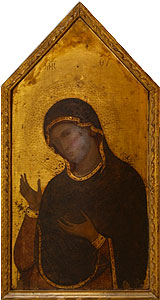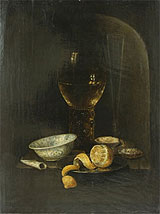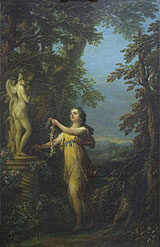Collection / European
Painting
 The ideals of the High Renaissance personified in the image of the New Man, brave and beautiful, were developed by the great Venetian masters Giorgione and Titian, who enriched the art of painting by their refined perception of nature. The painting of their younger contemporary Tintoretto (1518-1594) “Apollo and Pan” is a vivid example of the inventions of the High Renaissance. The mythological theme, man’s organic ties with nature, and the luxurious manner of painting are characteristic not only of the Venetian school but also of Tintoretto’s early artistic style imbued with optimism and harmony.
The ideals of the High Renaissance personified in the image of the New Man, brave and beautiful, were developed by the great Venetian masters Giorgione and Titian, who enriched the art of painting by their refined perception of nature. The painting of their younger contemporary Tintoretto (1518-1594) “Apollo and Pan” is a vivid example of the inventions of the High Renaissance. The mythological theme, man’s organic ties with nature, and the luxurious manner of painting are characteristic not only of the Venetian school but also of Tintoretto’s early artistic style imbued with optimism and harmony.
The art of the seventeenth century is represented by the works of two outstanding masters, Giovanni Guercino (1591-1666) and Bernardo Strozzi (1581-1644). The influence of both Baroque and Caravagism is noticeable in the “Portrait of Senator Bargellini” by Guercino. The paiting expresses virtuosity of characterization and rich colouring – as seen in the combination of silvery, black, and ochre. The features of the Baroque style can be seen in the works of the great Genoese master Bernardo Strozzi (1581-1644), represented by the “Portrait of Nicola Cucci“ (1673).This is a rare example of the painter’s works in this genre, for he preferred religious and  mythological topics. A series of works in the collection is dedicated to one of the favourite themes in the Italian art, the image of the Virgin. Francesco Mancini(1700-1758), Sebastiano Conca (1680-1764) and others have painted idyllic images endowed with lyricism and harmony, marked by the impact of the artistic tendencies of the time, Mannerism and Academic art. Works by
mythological topics. A series of works in the collection is dedicated to one of the favourite themes in the Italian art, the image of the Virgin. Francesco Mancini(1700-1758), Sebastiano Conca (1680-1764) and others have painted idyllic images endowed with lyricism and harmony, marked by the impact of the artistic tendencies of the time, Mannerism and Academic art. Works by  Italian masters of landscape are also exhibited in the Gallery. Giovanni Ghisolfi’s (1623-1683) “Landscape with Figures” is expressive in its figurative style and imbued with mystic spirit. Of great interest are the works by eighteenth century painters, whose landscapes bear the strong influence of the famous Venetian “veduta” master Canaletto (1697-1768).
Italian masters of landscape are also exhibited in the Gallery. Giovanni Ghisolfi’s (1623-1683) “Landscape with Figures” is expressive in its figurative style and imbued with mystic spirit. Of great interest are the works by eighteenth century painters, whose landscapes bear the strong influence of the famous Venetian “veduta” master Canaletto (1697-1768).
The Flemish and Dutch schools of painting, which originated in the Netherlands, flourished in the seventeenth century. The majority of the works in the Museum collection belongs to this period. Big altar pictures and monumental paintings for decorating churches and palaces, commissioned mainly by the elite and the church, determined the flourishing of the Baroque style in Flemish art. Characterized by an inclination for decoration, dynamism and grand images, this trend most vividly and fully manifested itself in the works of the  outstanding Flemish painters Pieter Paul Rubens (1577-1640), Jacob Jordaens (1593-1678), Frans Snyders (1579-1657), and others. Their work favoured the formation of the national style and greatly influenced other painters. The influence of the great master is apparent in the image of the Virgin with garlands of flowers, filled with optimism and cheerfulness, by an unknown painter of Ruben’s school. The national mentality is fully expressed in one of the best compositions of the collection, “Satyr Visiting a Peasant” by Jan Cossiers (1606-1671). The ancient Greek legend interpreted in Flemish spirit, with the usual personages, roughly modeled forms, rich colouring, and dynamic composition, endows the work with a character of genre painting, making it very expressive and impressive.
outstanding Flemish painters Pieter Paul Rubens (1577-1640), Jacob Jordaens (1593-1678), Frans Snyders (1579-1657), and others. Their work favoured the formation of the national style and greatly influenced other painters. The influence of the great master is apparent in the image of the Virgin with garlands of flowers, filled with optimism and cheerfulness, by an unknown painter of Ruben’s school. The national mentality is fully expressed in one of the best compositions of the collection, “Satyr Visiting a Peasant” by Jan Cossiers (1606-1671). The ancient Greek legend interpreted in Flemish spirit, with the usual personages, roughly modeled forms, rich colouring, and dynamic composition, endows the work with a character of genre painting, making it very expressive and impressive.
 The favourite genres of Flemish painting were still life and portrait. Flemish masters also liked to picture architectural scenes and church interiors. A striking example of this kind of painting in the Museum’s collection is “The Interior of a Gothic Temple” by Peeter Neeffs the Elder (1578-1656/61). A series of still lives by Gaspar Peeter Verbruggen (1664-1730), Jan Fyt (1611-1661) and some unknown masters are also noteworthy. One should especially mention the rare portraits by the sixteenth century Netherlandish painter Pourbus and an unknown master. Marked with restraint and laconism, this accurate treatment of details was characteristic of the painting of that time.
The favourite genres of Flemish painting were still life and portrait. Flemish masters also liked to picture architectural scenes and church interiors. A striking example of this kind of painting in the Museum’s collection is “The Interior of a Gothic Temple” by Peeter Neeffs the Elder (1578-1656/61). A series of still lives by Gaspar Peeter Verbruggen (1664-1730), Jan Fyt (1611-1661) and some unknown masters are also noteworthy. One should especially mention the rare portraits by the sixteenth century Netherlandish painter Pourbus and an unknown master. Marked with restraint and laconism, this accurate treatment of details was characteristic of the painting of that time.
 The historic victory of Holland in the seventeenth century and the end of Spanish domination changed the character of national art. The triumph of Protestantism resulted in the opposition of decorating churches with religious paintings. Secular motives became predominant in Dutch painting, leading the development of art to a new, realistic path. Favourite genres of Dutch painters were landscape, portraiture, still life, and scenes of everyday-life. Few but typical works of Dutch painters in the collection of the Gallery belong both to the leading and less known masters. Compositions of everyday-life scenes prevail in the collection. These include “A Singing Lesson” by Caspar Netscher (1639-1684), Pieter Codde’s (1599-1678) “A Company at the Table”, the picturesque images of village feasts, the so called “kermess” combining the landscape with ordinary scenes, such as Joost Cornelisz Droochsloot's (1586-1666) "Holiday", as well as tavern scenes and depiction of soldier’s life, etc. Dutch landscape painting of the seventeenth century is represented by “The View of Dordrecht” and the “Landscape” of the outstanding master Jan van Goyen (1596-1656), who was known for masterly technique of tonal painting. His landscapes are characterized by delicate transitions of ochre-brown colours depicting the light and humidity of air, and are hearty and lyrical images of his native country. Among the remarkable paintings kept in the Gallery is Allart van Everdingen’s (1621-1675) “Landscape with a Broken Tree”, an uncommon composition with a huge winding tree stem dominating the space of the painting.
The historic victory of Holland in the seventeenth century and the end of Spanish domination changed the character of national art. The triumph of Protestantism resulted in the opposition of decorating churches with religious paintings. Secular motives became predominant in Dutch painting, leading the development of art to a new, realistic path. Favourite genres of Dutch painters were landscape, portraiture, still life, and scenes of everyday-life. Few but typical works of Dutch painters in the collection of the Gallery belong both to the leading and less known masters. Compositions of everyday-life scenes prevail in the collection. These include “A Singing Lesson” by Caspar Netscher (1639-1684), Pieter Codde’s (1599-1678) “A Company at the Table”, the picturesque images of village feasts, the so called “kermess” combining the landscape with ordinary scenes, such as Joost Cornelisz Droochsloot's (1586-1666) "Holiday", as well as tavern scenes and depiction of soldier’s life, etc. Dutch landscape painting of the seventeenth century is represented by “The View of Dordrecht” and the “Landscape” of the outstanding master Jan van Goyen (1596-1656), who was known for masterly technique of tonal painting. His landscapes are characterized by delicate transitions of ochre-brown colours depicting the light and humidity of air, and are hearty and lyrical images of his native country. Among the remarkable paintings kept in the Gallery is Allart van Everdingen’s (1621-1675) “Landscape with a Broken Tree”, an uncommon composition with a huge winding tree stem dominating the space of the painting.
 In Holland the so-called “Italianate landscape” became widespread; it is represented by Cornelis van Poelenburgh’s (1586-1667) works “A scene in the Roman Campagna”, and “Landscape with Figures”, as well as works of Karel Dujardin (1622-1678) and Frederic de Moucheron (1633-1686). Many followers of this trend, though having not visited Italy treated its image with a special attention. This was done in order to specify motives and details characteristic of Dutchmen and create vivid pictured scenes.
In Holland the so-called “Italianate landscape” became widespread; it is represented by Cornelis van Poelenburgh’s (1586-1667) works “A scene in the Roman Campagna”, and “Landscape with Figures”, as well as works of Karel Dujardin (1622-1678) and Frederic de Moucheron (1633-1686). Many followers of this trend, though having not visited Italy treated its image with a special attention. This was done in order to specify motives and details characteristic of Dutchmen and create vivid pictured scenes.
Still life and portrait paintings have always formed an integral part of the Dutch interior. The Gallery possesses finest examples of Dutch still lives painted in the school of Willem Claesz Heda (1524-1680/82), as well as by the outstanding masters Pieter Claesz (1597-1661), Abraham van Beijeren (1620/21-1690), and others. They emphasize the material nature of household goods, achieving expressiveness and a somewhat poetic depiction of characters through their masterly manner of painting and refined correlations of colour and light.
 In Dutch portraits, typical features predominate over individual peculiarities. Matthias Stomer’s (1600-1672) composition “The Money- changer” attracts the viewer through the acute expression of typical traits and the social characterization of the model. The masters of this small country are often called “Small Dutchmen”. In their country painting had become an integral part of everyday life, intensifying the demand for works of art. This prompted Dutch painters to depict scenes of everyday life, and determined the intimate nature of many art works. This characterization relates not only to the painting’s lyrical nature but also to everyday themes of Dutch art.
In Dutch portraits, typical features predominate over individual peculiarities. Matthias Stomer’s (1600-1672) composition “The Money- changer” attracts the viewer through the acute expression of typical traits and the social characterization of the model. The masters of this small country are often called “Small Dutchmen”. In their country painting had become an integral part of everyday life, intensifying the demand for works of art. This prompted Dutch painters to depict scenes of everyday life, and determined the intimate nature of many art works. This characterization relates not only to the painting’s lyrical nature but also to everyday themes of Dutch art.
In contrast to other Western European artistic schools, French art is represented more comprehensively and embraces the longest period of time, from the seventeenth to the twentieth centuries. The works of the 18th century famous masters Jean Honore Fragonard (1732-1806), Fransois Drouais (1727-1775), Carle Van Loo (1705-1765), and Jean Baptiste Greuze (1725-1805) from the most important part of the French collection. Imbued with hedonistic spirit, characteristic of the Rococo style, and taste for theatricality, decorative style, and mythological topics, the works of the mentioned painters illustrate the atmosphere of their time, which was filled with sensuality and the strive to enjoy all the pleasures of life. “Rinaldo and Armida” ascribed to Fragonard is one of the most expressive compositions of the Rocaille style. The subject-matter borrowed from Torquato Tasso’s poem “Jerusalem Delivered” was wide-spread at that time, both in musiand painting. It can also be seen in the works by Jean-Baptiste Lully (1632-1687) and Francois Boucher (1703-1770).  The way of treating the images, the decorative nature of the landscape, and the rich colouring with silvery-green-rose tones, smooth lines, and vivid contours determines the high artistic quality of the work. And though Fragonard’s authorship is disputed, this canvas occupies its deserved place among the masterpieces of the collection. Like in the “Girl’s Head” by Greuze, the lovely and sweet appearance of the models, the delicate, light colouring, and smooth textures sometimes erase the distinction between rococo and salon art, which had greatly influenced the painter. The “Portrait of Princess Menshikova with Her Daughter” by Elizabeth Vigee Lebrun (1755-1842), popular in Europe and Russia, is a sample of salon painting which combines features of Sentimentalism and Classicism.
The way of treating the images, the decorative nature of the landscape, and the rich colouring with silvery-green-rose tones, smooth lines, and vivid contours determines the high artistic quality of the work. And though Fragonard’s authorship is disputed, this canvas occupies its deserved place among the masterpieces of the collection. Like in the “Girl’s Head” by Greuze, the lovely and sweet appearance of the models, the delicate, light colouring, and smooth textures sometimes erase the distinction between rococo and salon art, which had greatly influenced the painter. The “Portrait of Princess Menshikova with Her Daughter” by Elizabeth Vigee Lebrun (1755-1842), popular in Europe and Russia, is a sample of salon painting which combines features of Sentimentalism and Classicism.
The exposition of the Museum comprehensively reflects the evolution of French landscape painting. It begins with a painting of the seventeenth century by N. Poussin’s student Gaspar Dughet (1613/15-1675). The latter developed the stylistic traditions of Classicism, paying great attention to the problems of illumination. This endowed his landscapes with dramatic and tense character.The interest in effects of  illumination is also characteristic feature of Jozef Vernet (1714-1789). The famous seascape painter of the eighteenth century depicted shipwrecks, moonlit nights, and dawns, freshening the genre with distinctive tokens of reality. The collection also includes a series of works by Vernet’s younger contemporary Hubert Rober (1733-1808) who depicted the nature and monuments of his beloved Italy. The painter enlivened the majestic classical ruins with figures of people engaged in their everyday duties, imbuing his compositions with vividness. The development of realistic traditions in French art is connected with the landscape painters of the Barbizon school. The “Landscape” by the head of the school Theodore Rousseau (1812-1867) is characterized by monumentality, clear romantic intonations and stylistic features peculiar to the early period of the painter’s work. Narcisse Diaz de la Peña’s (1808-1876) painting too is romantic. This master painted mysterious landscapes, and through the course of time, under Rousseau’s influence, changed his artistic style, making it more realistic. Realistic tendencies continued developing in the work of the most brilliant representative of that trend Gustave Courbet (1819-1877). Though “Portrait of a Girl” kept in the collection of the Museum is one of his early works, and it is imbued with romantic spirit typical of the painter. The presence in the Gallery’s collection of works by Adolf Monticelli (1824-1886) and Eugene Boudin (1824-1896), the predecessors of Impressionism, as well, as unique compositions by Louis Anquetin (1861-1932), Maurice Brianchon (1899-1979) and later painters such as Bernard Buffet (1928-1999), make it possible to have an idea of some aspects of French painting of modern times.
illumination is also characteristic feature of Jozef Vernet (1714-1789). The famous seascape painter of the eighteenth century depicted shipwrecks, moonlit nights, and dawns, freshening the genre with distinctive tokens of reality. The collection also includes a series of works by Vernet’s younger contemporary Hubert Rober (1733-1808) who depicted the nature and monuments of his beloved Italy. The painter enlivened the majestic classical ruins with figures of people engaged in their everyday duties, imbuing his compositions with vividness. The development of realistic traditions in French art is connected with the landscape painters of the Barbizon school. The “Landscape” by the head of the school Theodore Rousseau (1812-1867) is characterized by monumentality, clear romantic intonations and stylistic features peculiar to the early period of the painter’s work. Narcisse Diaz de la Peña’s (1808-1876) painting too is romantic. This master painted mysterious landscapes, and through the course of time, under Rousseau’s influence, changed his artistic style, making it more realistic. Realistic tendencies continued developing in the work of the most brilliant representative of that trend Gustave Courbet (1819-1877). Though “Portrait of a Girl” kept in the collection of the Museum is one of his early works, and it is imbued with romantic spirit typical of the painter. The presence in the Gallery’s collection of works by Adolf Monticelli (1824-1886) and Eugene Boudin (1824-1896), the predecessors of Impressionism, as well, as unique compositions by Louis Anquetin (1861-1932), Maurice Brianchon (1899-1979) and later painters such as Bernard Buffet (1928-1999), make it possible to have an idea of some aspects of French painting of modern times.
To complete the general characterization of the collection, one should mention also the single works of painters from various countries: the works by Mariano Fortuni, by unknown masters of the Spanish school, the paintings by English, and Romanian artists, and the paintings of the famous American artist Rockwell Kent (1882-1971) which were presented by the artist. In the course of time those few paintings can become a basis for new sections of a foreign art collection.